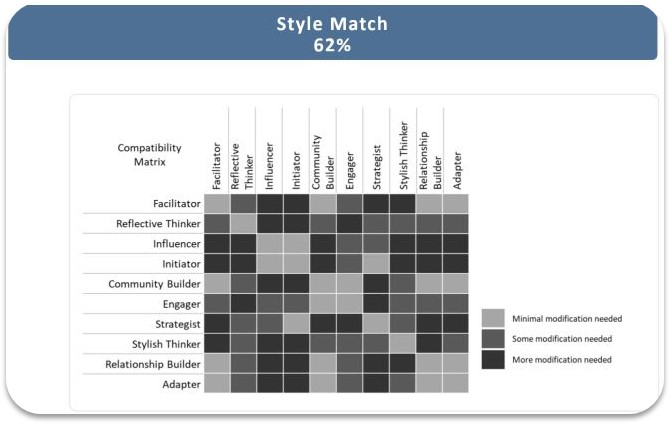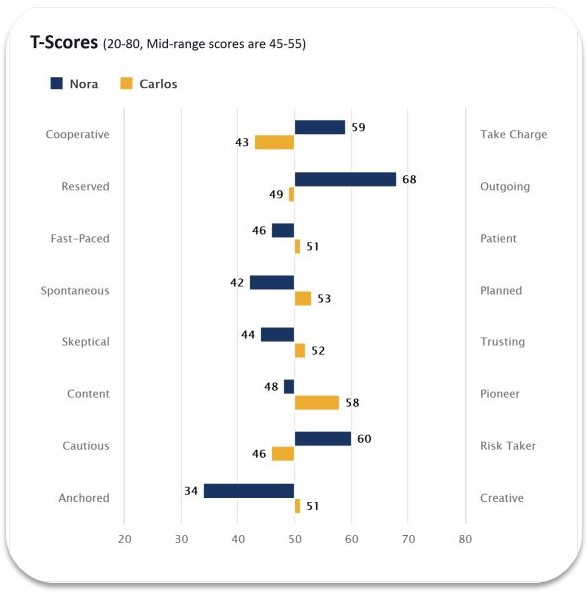Comparison Report for Managing Differences
This article applies to leaders, coaches, advisors, or persons looking to compare themselves to another employee, client, or person they interact with, or to compare 2 clients
Common Questions:
How do I debrief a comparison report?
What areas do I look at in reviewing a comparison report?
How do I manage or facilitate differences between 2 people?
Solution Overview:
Facilitation guidelines to remember:
- Best practice: If a blockage is sensed, meet with each person separately first before a combined discussion to finalize the plan so that the issues are fully heard without the discomfort of the other person being present.
- Remember the “party manners” may be on show with the natural behavior not fully revealed.
- Give the pair equal attention.
- Get the pair to talk – they will reveal their differences.
- In a financial planning situation, ensure the female partner’s needs are heard.
- Ensure the man feels respected and not left out of the conversation.
- Ask: To build relationship commitment, what is each person prepared to give up?
- Share: Have them openly talk about their strengths and admit their struggles – get understanding, acceptance, and respect of them from each of the pair
Note:
- The comparison report de-personalizes the issues, enabling a more straightforward discussion.
- Negative emotions are reduced because of the objectivity of the Natural DNA Behavior Discovery.
Some questions to think about when reviewing a comparison report:
- Given the context of the situation based on what you know now, where do you think each person may have to adapt with each other? However, be open to what you hear as the conversation unfolds.
- What questions would you have for this pair given their strongest differences? and also their similarities?
- How would you start the conversation with them?
- What points would you keep in mind to adapt to each style of the pair?
- Would this be a challenging pair for you to work with? Why?
Reviewing the Comparison Report
When reviewing a comparison report:
- You are seeking to address the impact of the differences on the pair, and yourself if you are one of the pair.
- Remember that the behaviors of the pair are gender-neutral.
- Based on the couple’s contextual situation and objectives - identify the fundamental patterns of behavior which will impact family decision-making.
- Before addressing work, life, interaction and financial issues with the pair, help them individually build greater understanding, acceptance, and respect for each other by knowing their natural behavior styles. That should take place through a review of their individual scores.
- A good starting point is to look at the Your Compatibility for Interacting and Managing Differences section of the report. This will give you immediate insight on the level of style match between the pair so that you will know what level of adapting will be needed by you as one of the pair or facilitating the pair.

- In using the Comparison report, review the two strongest factor scores for each of their pair – identify where there may one or both the same or opposite. Also, this will help you see the starting point for each person in how they approach situations and interact, and where they will most likely be locked in based on “hard-wiring”.
- Then, review the two or three most significant differences between the two people for the 8 primary factor scores, particularly where there is a difference of over ten points as measured by the T-Scores. This will provide insight into their different perspectives on work, life, money and how they will want to interact.
For instance, differences between the two people may reflect the following when they have opposite traits:
- Commanding Factor – one person is dominating regularly getting their way from being high Take Charge and with the other being more Co-operative.
- People Factor – there is difficulty connecting because one is very social and communicative from being Outgoing and the other is more Reserved and reflective.
- Patient Factor – feelings are hurt because one is Patient and more sensitive and the other is Fast Paced thereby straight to logic and problem-solving.
- Structure Factor – the one who is more Planned may seem more controlling because they prefer structure and do not like to be operating out of control while the other who is more Spontaneous is very flexible and more free-flowing.
- Trust Factor – the Trusting person will be more accepting of what happens whereas the Skeptical one could seem more difficult in the relationship because their discerning nature comes across with a sense of distrust.
- Pioneering Factor – one person is a Pioneer who is very driven and competitive about achieving goals and may express frustration at the more Content person who is prepared to accept the status quo and be more lifestyle focused.
- Risk Factor – one person through being a Risk-Taker could make decisions that threaten the safety of the more Cautious person who prefers to operate carefully and does not have a such high-risk tolerance.
- Creativity Factor – one person prefers to brainstorm and regularly come up with innovative ideas from being Creative can cause frustration for the Anchored person who is more focused on the existing way it is and proven procedures for execution.

- Also, review the two or three closest trait similarities between the two people for the 8 primary factor scores. In particular where both scores are stronger being closer to 80 or 20. That will provide insight into areas where the pair may have shared perspectives and be comfortable with each other, and also it may be where there is a potential relationship struggle.
For instance, similarities between the two people may reflect the following strengths and blind spots when they have the same traits:- Commanding - if the pair are both high on Take Charge there could be a lot of vision but a fight for control, or if they are both Co-operative then there may be a collaborative environment but a hesitancy in making decisions with no decisions getting made.
- People – if the pair are both high on Outgoing there will be high energy and socializing with people but a fight for the limelight could cause disagreement, or if they are both Reserved then they will enjoy the peace of low people energy but may not be open enough with each other and too guarded.
- Patient – if the pair are both high on patient, they will be kind to each other but may have a very strong fear of conflict and not confront each other when needed, or if they are both Fast-Paced they will both move quickly but that will cause friction if they are going in different directions.
- Structure – if the pair are both high on Planned then they will be very orderly and appreciate knowing where they stand but could be overly rigid, or if they are both Spontaneous, they will likely be very flexible and adapt to changing situations, but life could get chaotic if they are regularly going in different directions with few check-in boundaries.
- Trust – if the pair are both high on Trust then they will operate in a very friendly environment, but the challenge will be they do not check out what each are doing or saying to each other. Whereas, if both are Skeptical there will be a desire to establish the truth in everything, but it could mean relationship bonds are threatened with suspicion.
- Pioneering - if the pair are both high on Pioneer there will be a continual drive towards achieving goals which is only powerful if it is in the same direction, but it can create a competitive environment. If both are Content, then they will enjoy a relaxed environment, but it may get too steady without enough progression to achieve their goals.
- Risk – if the pair are both Risk Takers then they could be comfortable making bold decisions but also could fail to see danger, or if they are both Cautious then their careful decision-making approach may mean missing out on opportunities.
- Creativity – if the pair are both Creative they will share an innovative spirit but may get lost in execution, or if they are both Anchored then they will keep to what is practical but may not adapt when required
- Further insight into their different behaviors will be gained from looking at their respective twelve workplace insights scores. Look for the areas where one is high and the other low, or both high or both low. These areas will be potential clues as to where there is relationship strength or an area that needs to be addressed through conversation.
- The differences and similarities will provide insight into how their respective strengths, struggles, and communication styles impact the relationship. Review the most significant differences between their different strengths, struggles, and communication keys by looking at their Ultimate Performance Guide. What is the impact of the strengths, struggles, and communication styles on each person?
- Also, to learn more about behavioral insights read the book, “Leadership Behavior DNA” by Lee Ellis and Hugh Massie
Still Need Help?
Submit a ticket here.
![DNA-B-Primary_White (7).png]](https://kb.dnabehavior.com/hs-fs/hubfs/DNA-B-Primary_White%20(7).png?height=50&name=DNA-B-Primary_White%20(7).png)